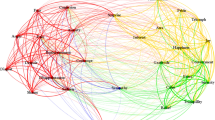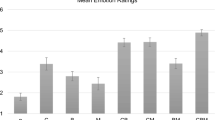Abstract
The normativity of emotions is a widely discussed phenomenon. So far embodied accounts have not paid sufficient attention to the various aspects of the normativity of emotions. In this paper it shall be pointed out that embodied accounts are constrained in the way they can account for the normativity of emotions due to their commitments to naturalism, externalism, and anti-vehicle-internalism. One way to account for the normativity of emotions within a naturalist framework is to describe the intentional objects of emotions as affordances that are of value for the organism. These affordances are part of a biological and social environment we are situated in, and they stand in complex relations to each other and to skillful organisms. I suggest that describing these relations can replace vehicle-internalist approaches but still account for the normativity of emotions within a naturalist framework.
Similar content being viewed by others
Notes
It is of course still highly controversial to what degree emotions are constituted by bodily reactions that have their origin in evolution. That cultural differences play an important role in emotion is beyond doubt. Yet even scientists such as Lisa Feldman-Barrett, who doubt that emotions can be individuated with regard to the patterns of bodily arousal they involve, would not deny that bodily arousal plays a central role in emotional coping strategies and that some basic bodily ingredients that combine to constitute different emotions can be identified (see e.g., Barrett et al. 2015). So today, even those who admonish theorists not to overestimate the role of bodily arousal make a much more differentiated claim than traditional cognitivists, who treat bodily arousal as a meaningless causal output or contingent byproduct of an emotion (e.g., Lazarus 1991; Nussbaum 2001). Still the debate about the individuation of emotions is not to be settled on empirical grounds. For the purposes of this paper, I will follow those who think that emotions can be individuated with regard to bodily reactions without further argument, but I argue for an embodied view in detail elsewhere (Hufendiek 2016).
Prinz (2004) is an exception here, since, strictly speaking, he is a vehicle-internalist. In arguing against cognitivists that emotions are perception-like rather than judgment-like Prinz suggests that the vehicles of emotions can be understood as being simple and non-conceptual in format. But for Prinz emotions are perceptions of bodily arousal and the vehicles of these perceptions are situated in the brain alone. The following discussion of the problems that anti-vehicle-internalists face when it comes to the normative dimension of emotions do include Prinz’s approach, though, since these problems are largely a result of denying that emotions are complex inner representations, such as judgments with a conceptual content.
This is not meant to exclude that emotions such as jealousy and guilt could be results of evolution with a biological function. I would like to remain neutral on the question of whether they are. What I claim is that guilt and jealousy have violations of social norms as their intentional objects. But I do not make any claims about how and why they became the objects of these emotions.
I develop the theory of action-oriented representations elsewhere (Hufendiek 2016) and argue that it makes sense to talk about representations being about affordances, although Gibson himself was a radical anti-vehicle-internalist who denied any notion of internal representation. Here I will focus on the intentional objects of emotions and leave the question of whether emotions are representations and subject to semantic norms open.
“Egoreception accompanies exteroception, like the other side of a coin” (Gibson 1986, p. 126).
See Rietfeld (2008) and Rietfeld and Kieverstein (2014) for an approach to affordances that are the result of our social practices or ways of living. See also H.L.A. Hart and his famous distinction between habits and rules. Hart proposes several conditions for a rule being present, including (i) regularity of behavior, (ii) a standard of criticism, (iii) a tendency to criticize for violations of the rule, and (iv) felt bindingness of the rule (Hart 1961).
Though this is the way that Searle would want to have it in his social ontology (2010). The reason not to follow Searle here is that an account such as Searle’s, which makes collective representation of something as something the constitutive principle of the social world, cannot account for DEE and SEE when it comes to our representing social rules or the violation of them. To fit the constraints on an embodied account, we need to think of the social world, as it comes to be represented in emotions, as being ontologically prior to the emotional responses in question.
I follow Haslanger’s (2015) description of social structure here. Such a description, again, has the advantage that it is not limited to Searle’s view that social entities can only be constituted by our collectively representing them as such. Haslanger does not apply the notion of social structure to animals. But as far as I can see, there is no in-principle reason why this should not be possible.
References
Barrett, L. F., Wilson-Mendenhall, C., & Barsalou, L. (2015). The conceptual act-theory. A roadmap. In L. F. Barrett & J. A. Russell (Eds.), The psychological construction of emotion (pp. 83–101). New York: Guilford.
Brooks, R. (1991). Intelligence without representation. Artificial Intelligence, 47, 139–159.
Chemero, A. (2009). Radical embodied cognitive science. Cambridge, MA: MIT Press.
Clark, A. (1997). Being there. Putting brain, body and world together again. Cambridge, MA: MIT Press.
Clark, J. (2010). Relations of homology between higher cognitive emotions and basic emotions. Biology and Philosophy, 25, 75–94.
Colombetti, G. (2007). Enactive appraisal. Phenomenology and the Cognitive Sciences, 6, 527–546.
Colombetti, G. (2010). Enaction, sense-making and emotion. In J. Steward, O. Gapenne, & E. Di Paolo (Eds.), Enaction: Toward a new paradigm for cognitive science (pp. 145–164). Cambridge, MA: MIT Press.
Colombetti, G. (2014). The feeling body. Affective science meets the enactive mind. Cambridge, MA: MIT Press.
Colombetti, G., & Krueger, J. (2015). Scaffoldings of the affective mind. Philosophical Psychology, 28(8), 1157–1176.
De Jaegher, H., & Di Paolo, E. (2007). Participatory sense-making. An enactive account to social cognition. Phenomenology and the Cognitive Sciences, 6, 485–507.
Deonna, J., & Terroni, F. (2012). The emotions. A philosophical introduction. New York: Routledge.
Descartes, R. (1649/1988). The passions of the soul. In J. Cottingham, R. Stoothoff, D. Murdoch (Trans. & Eds.), Selected philosophical writings of Renè Descartes. Cambridge: Cambridge University Press.
Draghi-Lorenz, R., Reddy, V., & Morris, P. (2005). Young infants can be perceived as shy, coy, bashful, embarrassed. Infant and Child Development, 14(1), 63–83.
Dretske, F. (1986). Misrepresentation. In R. Bogdan (Ed.), Belief: Form, content and function (pp. 17–36). Oxford: Oxford University Press.
Fodor, J. (2009). Where is my mind? London Review of Books, 31, 13–15. http://www.lrb.co.uk/v31/n03/jerry-fodor/where-is-my-mind.
Fuchs, T. (2013). The phenomenology of affectivity. In K. Fulford, et al. (Eds.), The Oxford handbook of philosophy and psychiatry (pp. 612–631). Oxford: Oxford University Press.
Gallagher, S. (2008). Are minimal representations still representations? International Journal of Philosophical Studies, 16(3), 351–369.
Gibson, J. (1986). The ecological approach to visual perception. New York: Psychology Press.
Gibson, W. T., Gonzalez, C. R., Fernandez, C., Ramasamy, L., Tabachnik, T., Du, R. R., et al. (2015). Behavioral responses to a repetitive visual threat stimulus express a persistent state of defensive arousal in Drosophila. Current Biology, 25(11), 1401–1415.
Griffiths, P. (1997). What emotions really are. The problem of psychological categories. Chicago: Chicago University Press.
Hart, H. L. A. (1961). The concept of law. London: Clarendon Press.
Hart, S. (2015). Jealousy in infants. Laboratory research on differential treatment. New York: Springer.
Haslanger, S. (2015). What is a (social) structural explanation? Philosophical Studies, 173(1), 113–130.
Helm, B. (2001). Emotional reason. Deliberation, motivation and the nature of value. Cambridge: Cambridge University Press.
Hutto, D. (2011). Philosophy of mind’s new lease on life: Autopoetic enactivism meets teleosemiotics. Journal of Consciousness Studies, 18(5–6), 44–64.
Hutto, D. (2012). Truly enactive emotion. Emotion Review, 4(2), 176–181.
Hutto, D., & Myin, E. (2013). Radicalizing enactivism. Basic minds without content. Cambridge, MA: MIT Press.
Kalueff, A. V., Stewart, A. M., Kyzar, E. J., Cachat, J., Gebhardt, M., Landsman, S., et al. (2012). Time to recognize zebrafish ‘affective’ behavior. Behaviour, 149, 1019–1036.
Kauppinen, A. (2014). Moral sentimentalism. Response-dependence supplement. In Stanford encyclopedia of philosophy. Accessed April 2016 from http://plato.stanford.edu/entries/moral-sentimentalism/supplement2.html.
Kelly, D. (2011). Yuck! The nature and moral significance of disgust. Cambridge (MA): MIT Press.
Kenny, A. (1963). Action, emotion, and will. London: Routledge.
Kreibig, S. (2010). Autonomic nervous system activity in emotion: A review. Biological Psychology, 84, 394–421.
Krueger, J. (2014). Emotions and the social niche. In M. Salmela & C. von Scheve (Eds.), Collective emotions (pp. 156–171). Oxford: Oxford University Press.
Lazarus, R. (1991). Emotion and adaptation. New York: Oxford University Press.
Lewis, M. (2014). The rise of consciousness and the development of emotional life. New York: The Guilford Press.
Maiese, M. (2011). Embodiment, emotion and cognition. Basingstoke: Palgrave Macmillan.
Millikan, R. (1993). White queen psychology and other essays for Alice. Cambridge, MA: MIT Press.
Millikan, R. (2004). Varieties of meaning. Cambridge, MA: MIT Press.
Nussbaum, M. (2001). Upheavals of thought. The intelligence of emotions. Cambridge: Cambridge University Press.
Parkinson, B., Fischer, A., & Manstead, A. (2005). Emotions in social relations, cultural, group, and interpersonal processes. New York: Psychology Press.
Prinz, J. (2004). Gut reactions. A perceptual theory of emotion. Oxford: Oxford University Press.
Prinz, J. (2007). The emotional construction of morals. Oxford: Oxford University Press.
Reddy, V. (2008). How infants know minds. Cambridge, MA: Harvard University Press.
Reed, E. (1996). Encountering the world. Toward an ecological psychology. New York: Oxford University Press.
Rietfeld, E. (2008). Situated normativity: The normative aspect of embodied cognition in unreflected action. Mind, 117(468), 973–1001.
Rietfeld, E., & Kieverstein, J. (2014). A rich landscape of affordances. Ecological Psychology, 26(4), 325–352.
Searle, J. (2010). Making the social world. The structure of human civilization. Oxford: Oxford University Press.
Slaby, J. (2014). Emotions and the extended mind. In M. Salmela & C. von Scheve (Eds.), Collective emotions (pp. 32–46). Oxford: Oxford University Press.
Solomon, R. (2003). Not passion’s slave. Emotions and choice. Oxford: Oxford University Press.
Tappolet, C. (2000). Emotions et valeurs. Paris: Presses Universitaires de France.
Thompson, E. (2010). Mind in life. Biology, phenomenology, and the sciences of mind. Harvard: Harvard University Press.
Tracy, J., & Robbins, R. (2007). The nature of pride. In J. Tracy, R. Robbins, & J. Tangney (Eds.), The self-conscious emotions. Theory and research (pp. 263–282). New York: The Guilford Press.
Turvey, M. (1992). Affordances and prospective control: An outline of the ontology. Ecological Psychology, 4, 173–187.
Watson, J. (1930). Behaviorism. New York: Norton.
Acknowledgments
I would like to thank Joshua Crabill, Markus Wild and two anonymous referees for their helpful comments on earlier versions of this paper. I would also like to acknowledge founding by the SNSF (Swiss National Science Foundation PP000P1_139037/2).
Author information
Authors and Affiliations
Corresponding author
Rights and permissions
About this article
Cite this article
Hufendiek, R. Affordances and the normativity of emotions. Synthese 194, 4455–4476 (2017). https://doi.org/10.1007/s11229-016-1144-7
Received:
Accepted:
Published:
Issue Date:
DOI: https://doi.org/10.1007/s11229-016-1144-7




